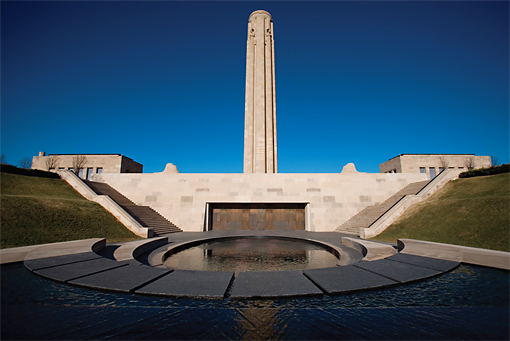| 제목 | [DAIKIN] MUSEUM - Liberty Memorial | 작성일 | 16-06-16 11:50 |
| 글쓴이 | 최고관리자 | 조회수 | 3,127 |
본문
CASE STUDY
Museum
Name
Liberty Memorial Museum
Location
Kansas City, MO USA
Facility Size
30,000 ft2 exhibit space,
20,000- ft2 research center
Issue
Needed excellent unloading capability, superior reliability, year-round cooling and humidification for a constant environment
Solution
(2) 275-ton Daikin water cooled centrifugal chillers with Daikin
fan coil units
Daikin Chillers Preserve Visitor Comfort at World War I Museum
With more than 49,000 priceless objects and artifacts in the Liberty Memorial Museum's 30,000-square foot exhibit space and 20,000-square foot research center in Kansas City, Missouri, the only thing they didn't have room for was error. That's why the museum insisted on Daikin centrifugal chillers for the HVAC system.
Originally dedicated in 1926, by President Calvin Coolidge, the Liberty Memorial Monument had fallen into disrepair and had literally closed its doors by 1994. Concerned Kansas City citizens and civic leaders rallied to restore and reopen the 217-foot high Beaux Arts tower and memorial buildings.
Major restoration of Liberty Memorial Monument began in 1998, following the approval of a half-cent sales tax. In 2004, Kansas City voters overwhelmingly passed a bond issue to renovate and expand the museum flanking the monument. The Missouri state legislature approved additional public funding. World-renowned museum designer Ralph Appelbaum, who designed the Holocaust Museum in Washington, D.C. and National Constitution Center in Philadelphia, PA, was selected to lead the project team.
Consulting engineers for the project, W. L. Cassell & Associates Mechanical and Electrical Engineers, worked closely together with Thermal Components Co., the Daikin representative in Kansas City, to select the best equipment for the museum's HVAC system.
Specified as the basis of the design, Daikin water cooled centrifugal chillers were chosen for the project. The museum needed a system with excellent unloading capability, superior reliability, year-round cooling and humidification control to maintain a constant environment for the valuable exhibits. The design of the museum is a flat deck leaving no room for exhaust fans or packaged rooftop units. Therefore Daikin water-cooled chillers were the ideal solution.
Hot summers and cold winters are the norm in Kansas City–which meant the chillers would have a light cooling load in the winters and a larger cooling load in the summers. And with the museum being officially named by the U.S. Congress as the National World War I Museum in 2004, tourism officials expected large crowds of visitors would also place higher demands on the chiller plant's cooling capacity.
During Phase I, the restoration of the building began on the 217-foot Memorial Tower and two exhibit halls. At that time the first of two Daikin centrifugal chillers was installed. During Phases II and III, when the shell space and the rest of the museum renovation were finished, the second Daikin chiller was installed along with Daikin fan coil units in the data closet, elevator and equipment rooms.
The two 275-ton Daikin water cooled centrifugal chillers cool 30,000 sq ft of exhibit space and 20,000 sq ft of research space. The museum exhibit areas feature highly interactive displays with computers, digital videos, plasma screens, fluid maps and light pens to bring history to life for visitors. These high-tech exhibits generate a lot of heat, which was another reason that the mechanical system team recommended Daikin water cooled centrifugal chillers.
In addition, energy-efficient Daikin chillers have the smallest footprint per ton in the industry, providing more cooling to the museum without requiring valuable floor space that was better used for exhibits.
Small size wasn't the only factor in selecting Daikin's chillers— quiet operation was just as important. The museum is filled with sights and sounds of World War I to recreate the experiences of those the war affected—the last thing visitors want to hear is the air conditioning system. And with Daikin, they won't. Daikin centrifugal chillers have a quiet compressor design with a unique refrigerant injection system to absorb sound energy so Daikin chillers run more quietly than most chillers.

Routine maintenance for one of two 275-ton Daikin water cooled centrifugal chillers.
The Liberty Memorial Museum also documents the damage the war did to the environment. In fact, one exhibit is a 20-ft. in diameter by 15-ft deep crater that shows what would be left of a building hit by a World War I explosive. With examples of environmental damage like this, Thermal Components recognized the need to recommend a product that would help to preserve and protect today's environment.
Daikin chillers have a positive pressure design and use HFC-134a refrigerant which has no ozone depletion potential, making it an environmentally sound choice for the museum. The fact that HFC- 134a has no phase-out schedule helps to make Daikin chillers a great longterm value for the museum as well.
The renovated, expanded National World War I Museum at Liberty Memorial officially opened its doors on December 2, 2006. Daikin is proud to be a part of this monument to "courage, honor, patriotism and sacrifice."
| 이전글 | [DAIKIN] MUSEUM - The Esplanade Arts Center 2016-06-16 | ||
| 다음글 | [DAIKIN] MUSEUM - Orlando Science Center 2016-06-16 | ||






